24.01.2021
NASA Invites Media to Next Space Station Cargo Launch With Northrop Grumman

Media accreditation is open for the launch from Virginia of Northrop Grumman’s 15th commercial resupply services mission to deliver NASA science investigations, supplies, and equipment to the International Space Station aboard its Cygnus spacecraft.
Northrop Grumman is targeting liftoff of its Antares rocket for no earlier than 12:36 p.m. EST Saturday, Feb. 20, from the Mid-Atlantic Regional Spaceport’s Pad-0A at NASA’s Wallops Flight Facility on Wallops Island, Virginia.
Due to the ongoing coronavirus pandemic, NASA will credential a limited number of media to cover the Antares launch from Wallops.
Both U.S. and U.S.-based international media must apply by 4 p.m. Tuesday, Feb. 2. All accreditation requests must be sent to Keith Koehler at keith.a.koehler@nasa.gov. International media from outside the United States will not be permitted to register for accreditation for this launch.
Each resupply mission to the station delivers scientific investigations in the areas of biology and biotechnology, Earth and space science, physical sciences, and technology development and demonstrations.
Research investigations launching to the orbiting laboratory aboard this Cygnus include:
- The Spaceborne Computer-2 from Hewlett Packard Enterprise, which aims to demonstrate that current Earth-based data processing of space station experimental data can be performed in orbit
- An experiment studying muscle strength in worms
- |An investigation into how microgravity may optimize the production of artificial retinas
Cargo resupply from U.S. companies ensures a national capability to deliver critical science research to the space station, significantly increasing NASA's ability to conduct new investigations at the only laboratory in space.
Quelle: NASA
----
Update: 2.02.2021
.
Northrop Grumman to launch next Cygnus cargo ship for NASA on Feb. 20
Liftoff is set for 12:36 p.m. EST (1736 GMT).

Experiments with worms and artificial retinas will ship to space Feb. 20 aboard a Northrop Grumman Cygnus spacecraft, according to a NASA announcement.
The cargo ship is scheduled to lift off no earlier than 12:36 p.m. EST (1736 GMT) from NASA's Wallops Flight Facility in Virginia, if all goes to plan. Only a limited number of U.S. media may go on site due to quarantine protocols associated with the novel coronavirus pandemic.
Cygnus will launch to the International Space Station aboard an Antares rocket and arrive at the orbiting lab two days later, according to NASA.
Some of the research investigations on board Cygnus include an experiment to study muscle strength in worms, an experiment concerning how microgravity may assist with artificial retina production, and the SpaceBorne Computer-2 experiment from Hewlett Packard Enterprise.
SpaceBorne Computer-2 "aims to demonstrate that current Earth-based data processing of space station experimental data can be performed in orbit," NASA said in the same statement. In general, processing data in space may reduce the amount of data sent to the ground, freeing communications channels for other tasks.
Cargo ships also carry essential items for spaceflyers including fresh food, equipment replacements or other items the crews may need to live in space for months at a time. After a few months, the crew fills departing Cygnus cargo ships with trash, which will burn up when the spacecraft re-enters the atmosphere.
When the last Cygnus spacecraft left the space station in January, it carried a high-speed 5G communications experiment along with the latest iteration in a series of science experiments investigating the behavior of fire in space, called Saffire-V. NASA plans to use these fire studies to improve astronaut safety on future missions, especially those in deep space.
Quelle: SC
----
Update: 6.02.2021
.
NASA Highlights Science on Next Northrop Grumman Mission to Space Station

NASA will host a media teleconference at 1 p.m. EST Thursday, Feb. 11, to discuss science investigations and technology demonstrations launching on Northrop Grumman’s 15th commercial resupply mission for the agency to the International Space Station.
Audio of the teleconference will be streamed live online at:
Northrop Grumman is targeting no earlier than 12:36 p.m. Saturday, Feb. 20, for the launch of its Cygnus spacecraft on an Antares rocket from the Mid-Atlantic Regional Spaceport’s pad 0A at NASA’s Wallops Flight Facility on Wallops Island, Virginia. The Cygnus spacecraft will carry crew supplies, scientific research, and hardware to the orbiting laboratory to support the Expedition 64 and 65 crews.
To participate in the teleconference, media must contact Monica Witt at 202-430-3781 or monica.j.witt@nasa.gov by 5 p.m. EST Wednesday, Feb. 10, for dial-in information.
Questions also can be submitted on social media using #AskNASA.
Heidi Parris, associate program scientist for the International Space Station Program at NASA’s Johnson Space Center in Houston, will provide an overview of the research and technology aboard the Cygnus spacecraft.
Also participating in the briefing are:
- Mark Fernandez, solutions architect for Converged Edge Systems at Hewlett Packard Enterprise and principal investigator of Spaceborne Computer-2, a high-performance commercial, off-the-shelf computer system being studied to increase data processing speeds for science aboard the space station
- Nicole Wagner, president and CEO of LambdaVision, and Jordan Greco, chief scientific officer of LambdaVision, who will discuss their second experiment being sent to the space station to study the advantages of manufacturing artificial retinas in space
- Siva Vanapalli, professor of chemical engineering at Texas Tech University in Lubbock, who will talk about Micro-16, an investigation studying muscle strength changes in worms to help better understand muscle weakening that astronauts can experience in microgravity
- Victoria Drago, a Ph.D. candidate at the University of Toledo in Ohio, who will share the Real-time Protein Crystal Growth-2 experiment, which will demonstrate new methods for producing high-quality protein crystals in microgravity
- Kerry Lee, Multi-Purpose Crew Vehicle (MPCV) Radiation System manager, who will discuss A-HoSS, a radiation detection system developed for the Orion spacecraft and certified for use on NASA’s Artemis II mission, the mission to carry a crew of astronauts aboard the spacecraft in orbit around the Moon
Cargo resupply from U.S. companies ensures a national capability to deliver critical science research to the space station, significantly increasing NASA's ability to conduct new investigations at the only laboratory in space.
The International Space Station is a convergence of science, technology, and human innovation that demonstrates new technologies and enables research not possible on Earth. NASA recently celebrated 20 years of continuous human presence aboard the orbiting laboratory, which has hosted 242 people and a variety of international and commercial spacecraft. The space station remains the springboard to NASA's next great leap in exploration, including future human missions to the Moon and eventually to Mars.
Members of the public can attend the launch virtually, receiving mission updates and opportunities normally reserved for on-site guests. To participate, members of the public can register for email updates to stay up to date on mission information, mission highlights, and interaction opportunities.
Quelle: NASA
----
Update: 12.02.2021
.
Go along for virtual ride from Wallops on an Antares rocket as NASA preps for mission

Northrop Grumman’s 15th resupply mission to the International Space Station launches from Wallops Island later this month, and NASA is inviting you to go along for the ride — virtually of course.
The Antares rocket carrying Northrop Grumman's Cygnus spacecraftwill take about 8,000 pounds of cargo, science and supplies to the International Space Station.
The science portion will include experiments that use worms to study muscle loss, examine how astronauts sleep and test high-powered computers in space, according to NASA.
Many of the experiments carried by this spacecraft build on previous studies conducted during the more than 20 years of continuous human habitation of the International Space Station.
The public can take part in virtual activities and events ahead of the launch of the commercial resupply services mission to the International Space Station.
The launch is targeted for Saturday, Feb. 20, at 12:36 p.m. from Pad-0A at NASA’s Wallops Flight Facility on Wallops Island.
NASA says its virtual launch experience for this mission includes curated launch resources, a behind-the-scenes look at the mission, notifications about NASA social interactions and the opportunity for a virtual launch passport stamp following a successful launch.
To participate, members of the public can register for email updates to stay up-to-date on mission information, mission highlights and interaction opportunities. To find out more, visit NASA's website.
Quelle: delmarva
----
Update: 14.02.2021
.
NASA TV Coverage Set for Next Cargo Launch to Space Station

NASA commercial cargo provider Northrop Grumman is targeting 12:36 p.m. EST Saturday, Feb. 20, for the launch of its 15th resupply mission to the International Space Station. Live coverage of the launch from NASA’s Wallops Flight Facility on Wallops Island, Virginia, will air on NASA Television, the agency’s website and the NASA app beginning at 12 p.m. EST Saturday, Feb. 20, with a prelaunch event Friday, Feb. 19.
Loaded with approximately 8,000 pounds of research, crew supplies, and hardware, Northrop Grumman’s Cygnus cargo spacecraft will launch on the company’s Antares rocket from Virginia Space’s Mid-Atlantic Regional Spaceport.
The Cygnus spacecraft, dubbed the SS Katherine Johnson, will arrive at the space station Monday, Feb. 22. About 4:40 a.m., Expedition 64Japan Aerospace Exploration Agency astronaut Soichi Noguchi will capture Cygnus, with NASA astronaut Michael Hopkins acting as a backup. After Cygnus capture, mission control in Houston will send ground commands for the station’s arm to rotate and install it on the station’s Unity module Earth-facing port.
Highlights of space station research facilitated by this Cygnus mission are:
- Spaceborne Computer-2, a high-performance commercial off-the-shelf computer system being studied to increase data processing speeds for science aboard the space station
- LambdaVision’s, second experiment headed to the space station to study the advantages of manufacturing artificial retinas in space
- Micro-16, an investigation studying muscle strength changes in worms to help us better understand muscle weakening that astronauts can experience in microgravity
- The Real-Time Protein Crystal Growth-2 experiment, which will demonstrate new methods for producing high-quality protein crystals in microgravity
- A-HoSS, a radiation detection system developed for the Orion spacecraft and certified for use on NASA’s Artemis II mission, the first mission on which a crew of astronauts will orbit the Moon in the spacecraft
- Exploration ECLSS: Brine Processor System, a demonstration in regenerative life support technology that will help provide more clean air and water to the space station crew.
Complete coverage of launch activities is as follows:
Friday, Feb. 19
11 a.m. – Pre-launch News Conference with the following participants:
- Joel Montalbano, manager, International Space Station Program, NASA
- Heidi Parris, associate program scientist, International Space Station Program Science Office, NASA
- Shannon Fitzpatrick, chief, Range and Mission Management Office, Wallops Flight Facility, NASA
- Frank DeMauro, vice president and general manager, Tactical Space, Northrop Grumman
- Kurt Eberly, director, Space Launch Programs, Launch and Missile Defense Systems, Northrop Grumman
Saturday, Feb. 20
12 p.m. – Launch coverage begins
Monday, Feb. 22
3 a.m. – Rendezvous coverage begins
4 a.m. – Capture of Cygnus with the space station’s robotic arm
6 a.m. – Cygnus installation operations coverage
Media can submit questions during the prelaunch news conference by emailing stephanie.schierholz@nasa.gov. Those following the briefing on social media may ask questions using #AskNASA.
Members of the public can attend the launch virtually, receiving mission updates and opportunities normally reserved for on-site guests. NASA’s virtual launch experience includes curated launch resources, a behind-the-scenes look at the mission, and the opportunity for a virtual launch passport stamp following a successful launch.
Register for email updates or RSVP to the Facebook event for social media updates to stay up to date on mission information, mission highlights, and interaction opportunities.
The Cygnus spacecraft is scheduled to remain at the space station until early May, when it will depart the station, disposing of several tons of trash during a fiery re-entry into Earth’s atmosphere.
Quelle: NASA
----
Update: 20.02.2021
.
Antares rocket loaded with time-sensitive cargo for launch to space station Saturday

The mission patch for Northrop Grumman’s NG-15 mission, with illustrations of the Antares rocket, the Cygnus supply ship, and the International Space Station. Credit: Northrop Grumman

A Northrop Grumman Cygnus supply ship — named the S.S. Katherine Johnson for the trailblazing NASA mathematician portrayed in “Hidden Figures” — was loaded with time-sensitive cargo Friday at a launch pad in Virginia for a midday blastoff Saturday toward the International Space Station.
The final few items were sealed inside the Cygnus cargo freighter Friday afternoon at the Mid-Atlantic Regional Spaceport, a facility owned by the state of Virginia co-located with NASA’s Wallops Flight Facility. With the last cargo loaded, ground crews planned to close the Cygnus catch, re-install the Antares rocket’s payload shroud, and raise the launcher vertical on pad 0A at Wallops.
The final preparations overnight will also include the attachment of the Antares rocket’s liquid oxygen loading line, and the arming of pyrotechnic ordnance before the start of the five-hour countdown leading to liftoff at 12:36:50 p.m. EST (1736:50 GMT) Saturday.
The 139-foot-tall (42.5-meter) Antares rocket has a five-minute launch window to take off Saturday. Forecasters at Wallops predict a 75% chance of favorable weather for launch, and the primary weather concerns are the potential for winds and clouds to violate flight criteria.
The mission, officially designated NG-15, will be Northrop Grumman’s 15th operational resupply launch to the space station since 2014. It will be the 14th flight of an Antares rocket.
Two Russian-made RD-181 rocket engines will power the Antares launcher off the pad with 864,000 pounds of thrust. The kerosene-fueled engines will steer the rocket toward the southeast from Wallops Island, Virginia, to align with the orbital path of the space station.
At about T+plus 3 minutes, 24 seconds, the Antares will shed its liquid-fueled first stage, followed soon after by separation of the rocket’s payload fairing and interstage adapter. A solid-fueled Castor 30XL upper stage will ignite at about T+plus 4 minutes, 7 seconds, for nearly three minutes to inject the Cygnus supply ship into a preliminary orbit in pursuit of the space station. The Cygnus cargo craft is scheduled to deploy from the Antares second stage at about T+plus 8 minutes, 52 seconds.
The Cygnus will unfurl its two fan-shaped solar panels within a couple of hours after liftoff, allowing the spacecraft to start charging batteries for the day-and-a-half trip to the space station. Astronaut Soichi Noguchi aboard the research complex will use the lab’s Canadian-built robotic arm to capture the commercial resupply vessel around 4:40 a.m. EST (0940 GMT) Monday, assuming an on-time launch Saturday.
Northrop Grumman names its Cygnus supply ships after pioneers in spaceflight. The Cygnus flying on the NG-15 mission is named for Katherine Johnson, a mathematician whose trajectory calculations were critical to the success of NASA’s earliest space missions.
“It’s our tradition to name each Cygnus after an individual who’s played a pivotal role in human spaceflight, and Mrs. Johnson was selected for her hand-written calculations that helped launch the first Americans into space, as well as her accomplishments in breaking glass ceiling after glass ceiling as a Black woman,” said Frank DeMauro, vice president and general manager for tactical space at Northrop Grumman.
The NG-15 mission’s cargo load adds up to 8,399 pounds, or 3,810 kilograms, including packaging and unpressurized equipment to assist in the deployment of several CubeSats at the end of the flight. That’s more than any previous commercial cargo mission to the space station.
NASA has contracts with Northrop Grumman, SpaceX, and Sierra Nevada Corp. for resupply flights to the station. SpaceX has launched 21 operational Dragon cargo missions to date, and the record cargo payload for a Dragon capsule is 6,913 pounds, or 3,136 kilograms, on a mission launched April 2016.
Sierra Nevada’s Dream Chaser spaceplane has not flown in space yet. Its first cargo mission to the space station is scheduled for 2022.
Here is a breakdown of the cargo on the NG-15 mission:
- Vehicle Hardware: 3,115 pounds (1,413 kilograms)
- Science Investigations: 2,484 pounds (1,127 kilograms)
- Crew Supplies: 2,054 pounds (932 kilograms)
- Unpressurized Cargo: 176 pounds (67 kilograms)
- Spacewalk Equipment: 52 pounds (24 kilograms)
- Russian Hardware: 52 pounds (24 kilograms)
- Computer Resources: 2 pounds (1 kilogram)
A few minutes after releasing the Cygnus spacecraft to fly to the space station, the Antares rocket will deploy 30 tiny student-built “ThinSats” from containers on the second stage. Each ThinSat is about the size of a slice of bread, and were integrated with sensors, transmitters, and circuit boards by students ranging in age from 4th grade to college from 13 states and the District of Columbia.
The ThinSat program is a partnership between the Virginia Commercial Space Flight Authority, which runs the Mid-Atlantic Regional Spaceport, Northrop Grumman, Twiggs Space Lab, NASA’s Wallops Flight Facility, and NearSpace Labs. The program is aimed at promoting education in Science, Technology, Engineering, and Mathematics, or STEM, fields.
The first 63 ThinSats launched on an Antares rocket in 2019. By releasing the tiny satellites in a low-altitude orbit, engineers can ensure the ThinSats naturally re-enter the atmosphere and burn up within a few days, minimizing their risk of becoming space junk.
Astronauts aboard the International Space Station will enter the Cygnus spacecraft within hours of its arrival Monday. They will unpack the experiments and supplies inside the cargo craft’s pressurized compartment, built by Thales Alenia Space in Italy.
The Cygnus will deliver a brine processor assembly for the space station’s water recycling system, which converts urine into fresh drinking water. NASA says the new brine processor will demonstrate an ability to recover more water from urine brine than feasible with current space station equipment, helping close the gap to meet requirements for long-duration human exploration missions to the moon and Mars.
The brine processor works by using special membranes to separate contaminants from the brine and allow water vapor to pass into the cabin atmosphere, where a condensing heat exchanger captures and delivers it to the station system that generates fresh water.
“Long-duration crewed exploration missions require about 98% water recovery, and there is currently no state-of- the-art technology in brine processing that can help achieve this goal,” NASA officials wrote in a fact sheet. “This brine processor system plans to close this gap for the urine waste stream of the space station.”
The Cygnus mission will also carry a new sleeping quarters for the space station’s seven-person crew. There are currently five crew members on the space station’s U.S. segment, with four astronauts who flew to the outpost on SpaceX’s Crew Dragon capsule in November, and astronaut Kate Rubins, who arrived in October on a Russian Soyuz spacecraft.
But the U.S. segment only has four sleep stations. Astronaut Mike Hopkins, commander of the Crew Dragon mission, has slept inside the SpaceX capsule docked to the space station.
Other hardware inside the Cygnus supply ship includes spare parts and support equipment for the space station’s toilets, and tanks of air to recharge the breathable atmosphere inside the space lab.
One of the research experiments on the NG-15 mission will investigate how microgravity affects the manufacturing of protein-based artificial retinas. Led by a Connecticut-based startup company named LambdaVision, the experiment is a follow-up to an investigation flown to the space station in 2018 that produced “very encouraging” results, according to Nicole Wagner, president and CEO of LambdaVision.
The company uses a “layer-by-layer” process to manufacture artificial retinas, which could be implanted in patients suffering from retinal degenerative diseases.
“This is the second of what we expect to be many, many flights (to the space station),” said Jordan Greco, chief scientific officer at LambdaVision. “This particular layering trial allows allow us to continue to gather critical information on the design of the system and to continue to probe the influence of microgravity on this layering process.”
“The work that we’re sending on NG-15 is we’re sending the protein materials, and we’re actually going to manufacture the artificial retina on the ISS. So we’re doing this layer by layer process on-board the International Space Station, and then those films will then be returned back to Earth for analysis,” Wagner said.
With funding support from NASA, LambdaVision is looking at extending the layer-by-layer manufacturing process to other applications besides artificial retinas, Wagner said.
The retina implants being developed by LambdaVision can restore “high-resolution vision” to patients by replacing the function of light-sensing rods and cones inside the eye, according to Wagner. The artificial retinas consist of a light-activated protein.
“We are just thrilled to have a chance to establish a foundation for producing products in low Earth orbit with true clinical benefits to patients, and in our casem for patients that are blinded by this devastating retinal degenerative disease,” Greco said.
Another experiment on the NG-15 mission will measure muscle strength in multiple generations of worms, including animals reared in space. Humans lose strength during long-duration space missions, but scientists want to better understand the biological changes caused by microgravity.
“To understand the biology, our project is focused on taking these … worms and looking at how the strength of these worms is changing,” said Siva Vanapalli, a professor of chemical engineering at Texas Tech University, and principal investigator of the experiment.
The experiment will launch with 1,000 worm larvae that will grow during the mission. The worms will produce offspring several times in space, according to Vanapalli.
A new device, called NemaFlex, will measure the worms’ muscle forces continuously. “If we do observe that our device is able to record these changes in strength, that opens up tremendous opportunities in conducting experiments on different drugs and figuring out how to maintain and improve the health of astronauts,” Vanapalli said.
The Cygnus will deliver to the space station a high-performance commercial off-the-shelf computer from Hewlett Packard Enterprise. Engineers will test the computer’s ability to process scientific data in space, potentially enabling researchers to produce quicker results from their experiments, according to NASA.
The cargo mission also carries a radiation detector that will fly on NASA’s Orion spacecraft. A successful test of the radiation monitor on the space station would validate the unit to fly on the first crewed Orion mission, Artemis 2, to the moon in 2023, NASA said.
Quelle: SN
+++
Start von Antares mit NG-15 Cygnus Cargo



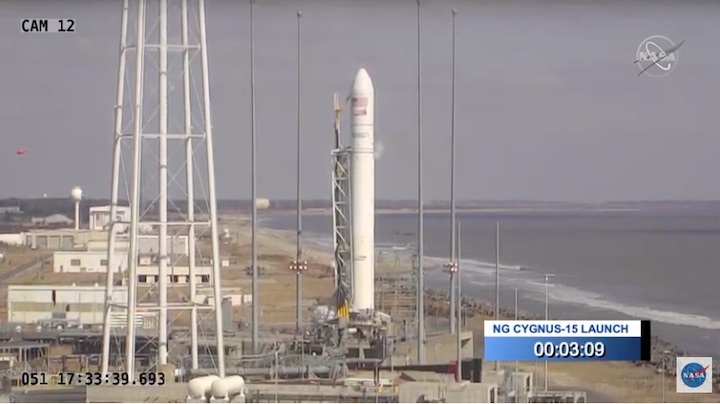

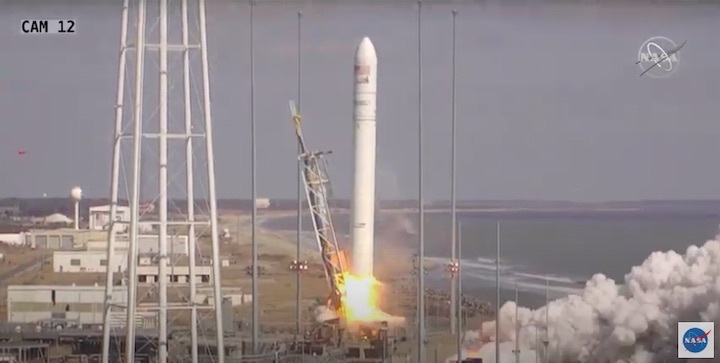



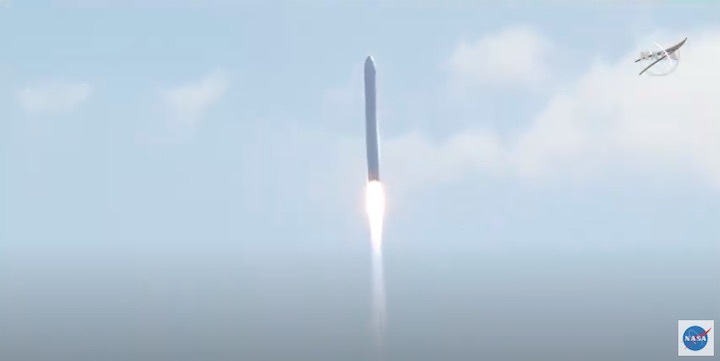






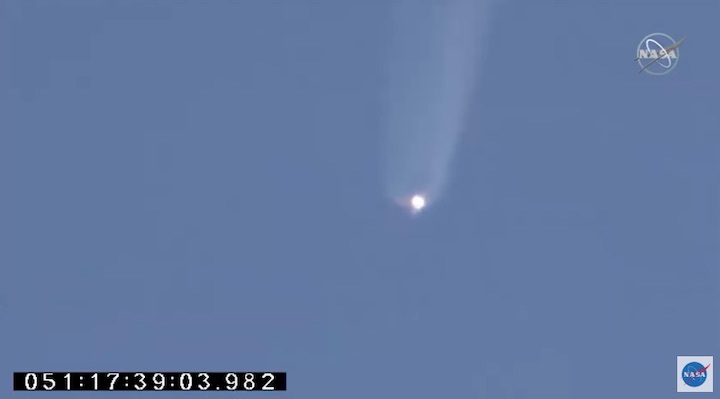



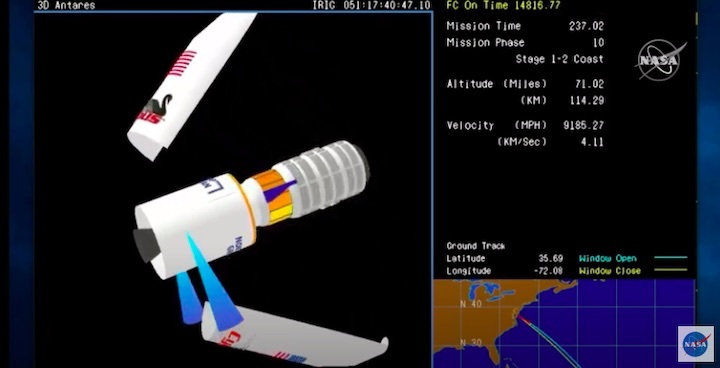








Quelle: NASA
+++
Update: 21.02.2021
.
NASA Science, Cargo Launches on 15th Northrop Grumman Resupply Mission to Space Station
Editor's note: Due to winter weather the Real-Time Protein Crystal Growth 2 study was unable to accompany the payload.
A Northrop Grumman Cygnus resupply spacecraft is en route to the International Space Station with approximately 8,000 pounds of science investigations and cargo after launching at 12:36 p.m. EST Saturday from NASA’s Wallops Flight Facility in Virginia. About three hours after launch, the spacecraft’s solar arrays successfully deployed to collect sunlight to power Cygnus on its journey to the space station.
NASA Television, the NASA app, and agency’s website will provide live coverage of the spacecraft’s approach and arrival beginning at 3 a.m. Monday, Feb. 22. Cygnus is scheduled to arrive at the space station around 4:40 a.m.
Japan Aerospace Exploration Agency (JAXA) astronaut Soichi Noguchi will use the space station’s robotic Canadarm2 to capture Cygnus upon its arrival, while NASA astronaut Michael Hopkins monitors telemetry during rendezvous, capture, and installation on the Unity module’s Earth-facing port.
Northrop Grumman’s 15th cargo flight to the space station is the fourth under its Commercial Resupply Services 2 contract with NASA. Cygnus launched on an Antares 230+ rocket from the Virginia Mid-Atlantic Regional Spaceport’s Pad 0A at Wallops.
The resupply flight will support dozens of new and existing investigations. Included in the scientific investigations Cygnus is delivering to the space station are:
Using worms to learn about muscle loss
Tiny worms could help us determine the cause of muscle weakening that astronauts can experience in microgravity. Thanks to a new device for measuring the muscle strength of tiny C. elegans worms, researchers with the Micro-16 study can test whether decreased expression of muscle proteins is associated with this decreased strength. Results of this experiment may provide a better understanding of the links between gene expression and muscle strength, support the development of countermeasures to help maintain crew member health, and support new therapies to combat the effects of age-related muscle loss on Earth.
I dream of space
The ESA (European Space Agency) Dreams experiment will take a closer look at astronaut sleep. The investigation serves as a technology demonstration of the Dry-EEG Headband in microgravity, while also monitoring astronaut sleep quality during a long-duration flight mission. Raw data will be available to scientists for their analysis, while the crew also can input direct feedback on their sleep with a tablet application. Sleep is central to human health, so a better understanding of sleep in space provides a more comprehensive understanding of human health in microgravity.
A life support upgrade
The Environmental Control and Life Support System (ECLSS) is a system of regenerative life support hardware that provides clean air and water to the space station crew. The system will get an upgrade thanks to the Exploration ECLSS: Brine Processor System. This investigation demonstrates technology to recover additional water from the Urine Processor Assembly using a membrane distillation process. Long-duration crewed exploration missions require about 98% water recovery, and this technology demonstration in brine processing will help achieve this goal. This Brine Processor System plans to close the gap for the urine waste stream of the space station.
Testing the manufacturing of artificial retinas in microgravity
Millions of people on Earth suffer from retinal degenerative diseases. Artificial retinas or retinal implants may provide a way to restore meaningful vision for those affected. In 2018, startup LambdaVision sent its first experiment to the space station to determine if the process used to create artificial retinal implants by forming a thin film one layer at a time may work better in microgravity. LambdaVision’s second experiment evaluates a manufacturing system using a light-activated protein that replaces the function of damaged cells in the eye. This information could help LambdaVision uncover whether microgravity could optimize production of these retinas and assist people back on Earth.
Preparing for the Moon
The International Space Station serves as a testing ground for technologies we plan to use on future missions to the Moon. The A-HoSSinvestigation puts tools for the crewed Artemis II mission to the test. Built as the primary radiation detection system for the Orion spacecraft, the Hybrid Electronic Radiation Assessor (HERA) was modified for operation on the space station. By verifying that HERA can operate without error for 30 days, it validates the system for crewed Artemis mission operations.
High-performance computing aboard the space station
Improved high-performance computing will be required for space missions as humans prepare for additional exploration throughout the solar system. Currently, computing capabilities in space are reduced compared to capabilities on the ground because they prioritize reliability over performance, creating challenges when transmitting data to and from space. Launched in 2017, the Spaceborne computer study ran a high-performance commercial off-the-shelf computer system in space, successfully performing more than 1 trillion calculations (or one teraflop) per second for 207 days without requiring reset. Now launching on Northrop Grumman’s CRS-15 mission, Spaceborne Computer-2 explores how commercial off-the-shelf computer systems can advance space exploration by reliably processing data significantly faster in space, speeding scientists’ time to data access and analysis from months to minutes.
These are just a subset of the hundreds of investigations currently being conducted aboard the orbiting laboratory in the areas of biology and biotechnology, physical sciences, and Earth and space science. Advances in these areas will help keep astronauts healthy during long-duration space travel and demonstrate technologies for future human and robotic exploration missions as part of NASA’s Moon and Mars exploration approach, including lunar missions through NASA’s Artemis program.
The lead NASA flight director for the mission is Adi Boulos. “I am humbled to be the International Space Station Flight Director for the Northrup Grumman CRS-15 mission,” Boulos said. “This spacecraft has the honor of being named the S.S. Katherine Johnson. As a Black woman, Katherine Johnson shattered race and gender barriers to live out her dreams and become a pivotal part of this country’s young space program. Fifty-nine years ago today, astronaut John Glenn became the first American to orbit Earth after personally asking for Katherine Johnson to verify his Mercury missions’ orbital trajectory calculations. Katherine Johnson was an asset to our space program, and I am honored to work for a mission that expands her legacy even further.”
The Cygnus spacecraft will remain at the space station until May before it disposes of several thousand pounds of trash through its destructive re-entry into Earth’s atmosphere.
Quelle: NASA
